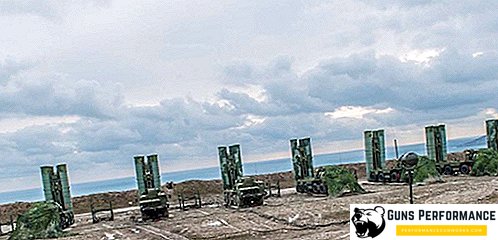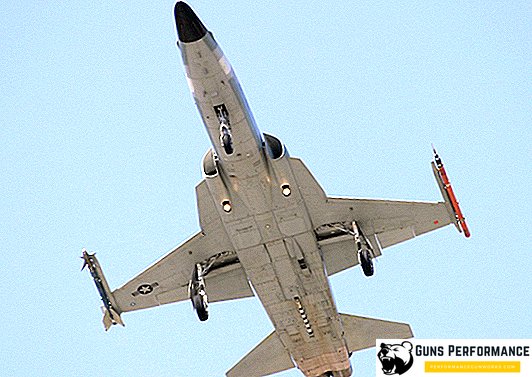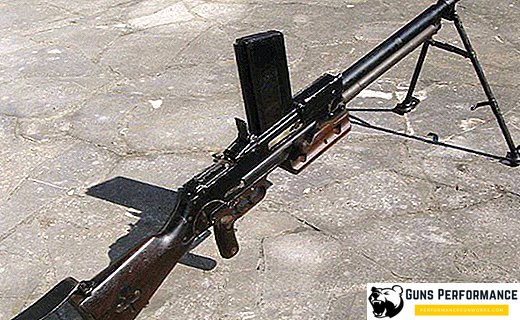
The Il-96 is a wide-body passenger aircraft, the creation of which began in the Ilyushin Design Bureau as early as the late 70s of the last century. This aircraft was the first car of this class, developed in the Soviet Union. The first flight of the IL-96 made in 1993.
Serial production of the IL-96 aircraft was deployed at the Voronezh aircraft factory, in all, since its inception, 30 airbuses were manufactured.
At present, the Il-96 is operated by the Special Flight Squad "Russia", which also includes the presidential side. Since 1996, Russian leaders have been flying the IL-96-300PU - modifications of the airliner, created specifically for the head of state. In 2003, a new aircraft of this modification was built for Putin.

IL-96 is considered to be one of the most reliable passenger aircraft in its class. Since the start of operation with these machines has not happened a single accident, which would lead to casualties. True, the total flight time of these aircraft is much lower than that of their foreign counterparts.
Also IL-96 is operated by the Cuban company Cubana. In 2014, Aeroflot wrote off the last six IL-96, citing such a move by the high cost of their operation.
We can say that this plane was very unlucky, because the moment of its birth fell on the period of the collapse of the country and the economic crisis, when the domestic aviation industry literally survived, and it was not up to the renewal of the aircraft fleet. In the late 90s, an attempt was made to modernize the aircraft, the result of which was the appearance of the IL-96-400 modification. However, she was not too interested in domestic airlines, orders from the airlines did not follow.
IL-96 can be called one of the most well-known and discussed domestic passenger aircraft. Interviews of high-ranking Russian officials with promises of an early resumption of production of the IL-96 aircraft appear with enviable periodicity in the press. But things are there.
If we talk about the latest news related to this aircraft, then at the beginning of this year, Deputy Prime Minister Rogozin visited the Voronezh aircraft factory and promised government support to aircraft manufacturers. According to the official, the IL-96-400 is fully capable of covering the needs of domestic airlines for long-haul wide-body aircraft, until a new Russian-Chinese airbus is ready.
Earlier, Industry Minister Manturov promised to allocate 50 billion rubles for resuscitation of the production of IL-96. However, according to him, first it is necessary to solve the problem of excessive fuel “voracity” of the car, because according to this characteristic the IL-96 cannot compete with the Boeing-767 and 777 or the Airbus 330 - its main competitors.

Despite all the difficulties of the early 90s, the new IL-96 had good prospects. At that time, foreign companies were seriously interested in the car. Especially for the promotion abroad, the Il-96M was developed with Pratt & Whitney engines and advanced Western avionics. In 1993, the prototype of this aircraft already flew, and soon he received Russian and American certificates. Why is this project and could not bring to mind? And does he have a chance to take a worthy place in the sky?
History of creation
Work on the creation of the Soviet wide-body passenger aircraft began in the first half of the 70s. At that time, the majority of long-haul traffic in the Soviet Union and the countries of the socialist camp were carried out on an Il-62 airliner. However, this aircraft, built in the early 60s, at that moment could no longer cope with the significantly increased passenger traffic. Because of its low capacity, it was necessary to increase the number of flights, which created an excessive load on airports. In addition, this aircraft in terms of comfort was significantly inferior to its Western counterparts.
A wide-body passenger aircraft is a machine with a fuselage diameter of 5-6 meters. These sizes allow you to fit in the same row from 6 to 10 seats. It should be noted that the appearance of long-distance wide-body passenger liners almost immediately made narrow-body aircraft unprofitable. They had to be transferred to routes with a small passenger traffic. An analysis conducted in the USSR in the mid-70s showed that within ten years Aeroflot would not be able to provide transportation on long-haul lines without a spacious wide-body airliner.
At this time in the OKB. Ilyushin was engaged in the development of a new large-capacity passenger aircraft Il-86. On the basis of this car, it was decided to build a new long-range passenger aircraft. He received the name of the IL-86D. It differed little from the basic modification: only the wing area and the power plant, which consisted of more economical engines with a higher bypass ratio, increased. The idea to create two aircraft with a high degree of unification seriously reduced the development time of new cars, reduced their cost, and in the future should have greatly simplified maintenance.
However, IL-86D was not embodied in the metal. In the late 70s, at its base, it was decided to create a new long-distance passenger car - the IL-96 aircraft. Changes were made to the design of this machine, which made it possible to significantly increase its technical perfection.

At the turn of the 70s and 80s, aviation technologies developed so rapidly that after completing work on the IL-96, the designers had to once again take on the work again and create a fundamentally new project, because the plane they had created was already serious at the start of their career. lagged behind Western counterparts. The new prospective liner was named IL-96-300, and in its development, the IL-86 liner and aggregates were no longer used.
The first takeoff of the IL-96-300 took place in September 1988, the tests continued until the end of 1992, after which the aircraft was certified. In 1989, the aircraft was demonstrated at the Le Bourget Air Show. If we talk about the flight characteristics of the new machine, it can be noted that the designers managed to reach a new level, compared to the aircraft created in the OKB Design Bureau. Ilyushin earlier. For example, the fuel consumption of the IL-96-300 per passenger-kilometer was two times lower than that of the long-haul IL-62.
For work on the creation of a new aircraft, the OKB team. Ilyushin was awarded the State Prize.
The first IL-96-30 were transferred to the Domodedovo squadron, the commercial operation of the Airbus began in 1993. Initially, the ships were mainly used for flights on international routes.
A serious blow to the further development of the IL-96 project was the decision of the Russian government to lift duties on the import of foreign large-capacity planes into the country. He was frankly lobbied by Aeroflot, promising to purchase a large batch of IL-96 in the event of a reduction in duties. The decision was made, but the purchase of domestic aircraft did not take place.
In 2000, a new modification of the liner, the IL-96-400, was developed, which had a greater passenger capacity and increased flight range. However, this aircraft did not interest domestic air carriers, only a few IL-96-400T were purchased - the transport version of this aircraft.

In the middle of the 2000s, three Il-96-300s were sold to Cuba, one of which was made in the "presidential" version. Now not only Putin is flying to the IL-96, but also the top leadership of the “Island of Freedom”.
Over the years, negotiations on the supply of aircraft conducted with China, Syria, Iran, Peru and even Zimbabwe. They did not have much success.
In 2009, the government declared the need to remove the IL-96-300 from production, ostensibly because it cannot compete on equal terms with the latest European and American counterparts.
In 2014, Aeroflot decommissioned all of the Il-96 belonging to the company.

However, as early as next year, the Ilyushin Aviation Complex OJSC announced plans for the next modernization of the IL-96 and the resumption of its serial production. The following year, representatives of the company reported that they are engaged in improving the liner's fuel efficiency and plan to bring it to the level of modern Western analogues. The general director of the Voronezh aircraft factory announced that the IL-96-400M will be ready by 2019. And the government has already promised to allocate funds for this project.
In February of this year, a message appeared in the media that a firm contract was signed between the manufacturer and the KLA for design work on the IL-96-400M. The production time of the prototype aircraft is 2019.
Description of construction
The IL-96-300 is a free-carrying wide-body low-wing with four engines, vertical tail and swept wings.

The aircraft fuselage has a diameter of 6.08 meters, depending on the layout of the passenger cabin, it can accommodate from 235 to 300 passengers. With the standard layout (300 seats), the passenger cabin is divided into two salons, in the front cabin there are 66 seats, and in the rear - 234 seats. They are arranged in a row of nine seats with a pitch of 870 mm and two aisles of 550 mm each. Airplanes with a passenger capacity of 235 people have a passenger cabin divided into three cabins: first class (22 seats with a distance between rows of 1020 mm), business class (40 seats) and economy class (173 seats). Salon IL-96 in terms of comfort for passengers is not inferior to the best foreign analogues.

The bottom deck of the IL-96-300 is occupied by cargo compartments. There are three of them, the first two can receive nine standard aviation containers ABK-1.5, and the third is intended for transportation of piece cargo.
The IL-96 has a wing with a span of more than 60 m and an area of 391 m2 with large vertical tips at the edges. In terms of area it is significantly (70 m2) larger than the wing of the IL-86 and equipped with sophisticated mechanization. It includes slats, which occupy the entire length of the leading edge, and double-slit flaps.
The vertical tail of the aircraft also has significant dimensions, it is one and a half meters higher than that of the IL-86. This feature of the liner allows it to maintain stability in flight, even if one of the engines fails.
IL-96 has four landing gear: three main, located under the center section, and the front rack. Each of the main pillars has a four-wheeled cart with brake wheels, and the front pillar is equipped with two non-brake wheels. The size of all the wheels of the aircraft landing gear is the same.

The power plant of the liner consists of four turbofan engines with a high degree of bypass ratio PS-90A, which can create thrust of 16 thousand kgf. They are installed in pylons that are attached to the wing consoles. PS-90A is made on a two-shaft scheme, there is a reverse. The engine is equipped with a four-stage low pressure turbine and a two-stage - high. PS-90A is distinguished by its modular design, which facilitates its maintenance: if necessary, one of the eleven existing modules can be quickly replaced.
For the first time in the history of the Soviet aircraft industry, the aircraft’s propulsion system was equipped with the Diagnosis-90 electronic command and control system, which had two channels. This system automatically monitors fuel consumption and protects engines from surge. Promising IL-96-400M plan to equip the new engine PD-35, which is currently being developed.

The newest (for its time, of course) flight-navigation complex was installed on the IL-96-300, which made it possible to abandon the navigator and get along with a crew of three. The IL-96-300 is the first Soviet machine that was equipped with an electronic control system for the VSUP-85-4 flight - in addition to traditional analog devices, electronic indicators also appeared in the IL-96-300 cabin. This aircraft is equipped with an EDS system.
The airbus fuel system is in many ways reminiscent of a similar IL-86 system. The fuel is located in nine caisson tanks, from where it is pumped into the pre-expendable tank and, further, into the supply compartment, which each engine has. Four tanks are in the wing consoles, another one is located in the center section.
IL-96-300 is equipped with an automatic air conditioning system. The air in the cabin is supplied from the engines.

The aircraft is equipped with an electric anti-icing system. Air intakes are heated by air that flows from the compressor chamber.
Modifications
Since the start of serial production of the Il-96 aircraft, several modifications of the machine have been developed. Below are the main ones:
- IL-96-300. Basic modification, equipped with four PS-90A engines. The liner first flew into the sky in September 1988 and entered service at Aeroflot in 1993. A total of twenty aircraft of this modification were produced, in 2009 it was decided to discontinue it. This car has a maximum range of 13.5 thousand km, it can take on board up to 300 passengers;
- Il-96-300PU / PU (M1). "Presidential" modification of the liner, which was specially developed on the basis of the IL-96-300 for the transportation of the first persons of the country. All were built five aircraft of this modification. The letters "PU" in the designation of the machine means "control point". According to its characteristics, it practically does not differ from the basic version of the machine, the range of the airliner is slightly increased. In essence, the Il-96-300PU is an air command post that allows you to control the country and the armed forces during a nuclear conflict. Externally, this airliner is practically no different from a conventional production aircraft. This car was made in 1995 for the first Russian president Boris Yeltsin. The second Il-96-300PU was created for Vladimir Putin, he first took to the air in 2003. The last aircraft of this modification was manufactured at the end of 2018;
- IL-96-400. Modification of the aircraft, which was developed in 2000. The car has a longer fuselage compared to the IL-96-300, it is equipped with PS-90A-1 engines (traction of 17.4 thousand kgf) and more advanced avionics. This liner can take on board 435 passengers;
- IL-96-400T. Transport version of the IL-96-400 airliner. The first car was assembled in 2007, just four aircraft were made. In 2014, one of the IL-96-400Ts was decided to be converted into an air control center for the needs of the Federal Security Service of the Russian Federation. In 2018, the Russian Ministry of Defense announced the purchase of two aircraft in the modification "tanker". If the operation of these aircraft goes successfully, the military department is ready to order another 30 cars;
- IL-96-400TZ. This is an aircraft tanker, created on the basis of the IL-96-400T. It will be able to transmit 65 tons of fuel at a distance of 3.5 thousand km;
- Il-96VKP. This modification of the liner is a strategic air command center. At present, the Ilyushenians are working on its creation, in the future this aircraft will replace the IL-86VKP;
- IL-96M. Modification of the base model IL-96-300 with an extended fuselage, Pratt & Whitney engines and Western avionics. The prototype of this car took off for the first time in April 1993, and later was repeatedly demonstrated at various air shows. In 2009, cut into scrap;
- IL-96MD. Modification of the aircraft, equipped with engines Pratt & Whitney PW4082;
- IL-96MK. Modification with four engines NK-92.

Specifications
Below are the main LTH IL-96-300:
- empty mass, kg - 117000;
- length, m - 55.35;
- height, m - 17.55;
- wing area, m2 - 391.6;
- cruising speed, km / h - 850;
- Max. speed, km / h - 910;
- range, km - 9000;
- ceiling, m - 11,500;
- number of seats for passengers - 230-300;
- crew, people - 3.













